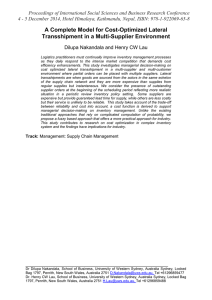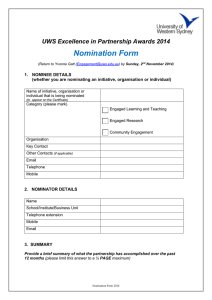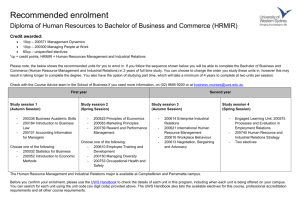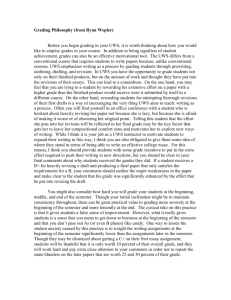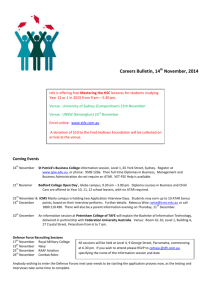Settlement Council of Australia, Creating Our Future 2012 Conference
advertisement
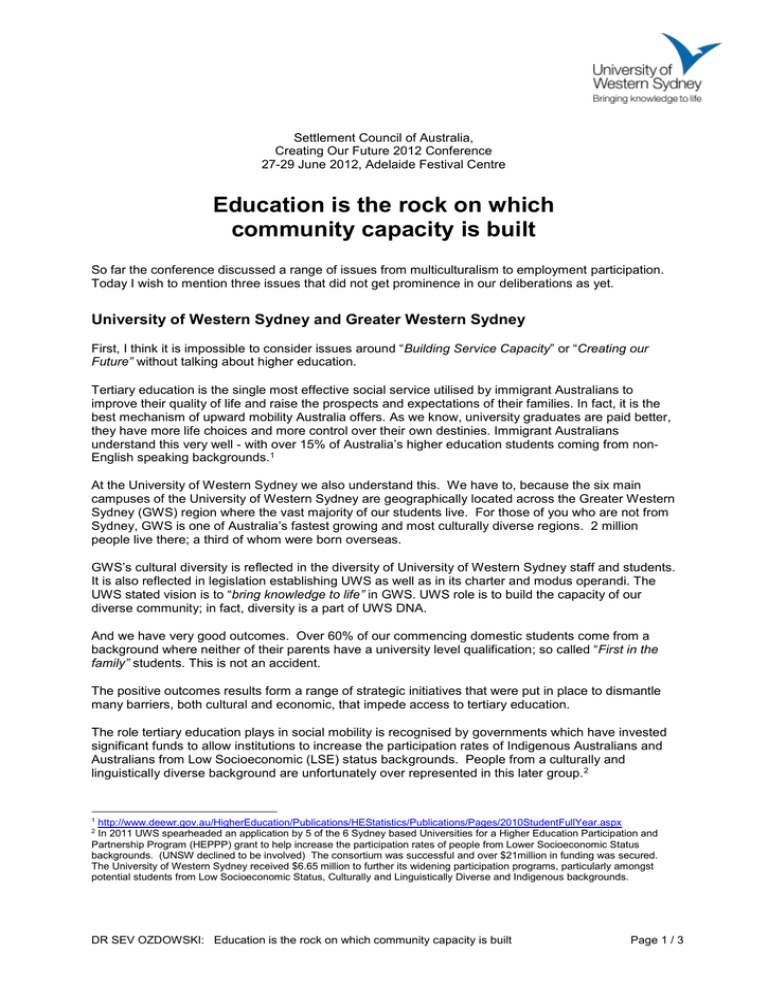
Settlement Council of Australia, Creating Our Future 2012 Conference 27-29 June 2012, Adelaide Festival Centre Education is the rock on which community capacity is built So far the conference discussed a range of issues from multiculturalism to employment participation. Today I wish to mention three issues that did not get prominence in our deliberations as yet. University of Western Sydney and Greater Western Sydney First, I think it is impossible to consider issues around “Building Service Capacity” or “Creating our Future” without talking about higher education. Tertiary education is the single most effective social service utilised by immigrant Australians to improve their quality of life and raise the prospects and expectations of their families. In fact, it is the best mechanism of upward mobility Australia offers. As we know, university graduates are paid better, they have more life choices and more control over their own destinies. Immigrant Australians understand this very well - with over 15% of Australia’s higher education students coming from nonEnglish speaking backgrounds.1 At the University of Western Sydney we also understand this. We have to, because the six main campuses of the University of Western Sydney are geographically located across the Greater Western Sydney (GWS) region where the vast majority of our students live. For those of you who are not from Sydney, GWS is one of Australia’s fastest growing and most culturally diverse regions. 2 million people live there; a third of whom were born overseas. GWS’s cultural diversity is reflected in the diversity of University of Western Sydney staff and students. It is also reflected in legislation establishing UWS as well as in its charter and modus operandi. The UWS stated vision is to “bring knowledge to life” in GWS. UWS role is to build the capacity of our diverse community; in fact, diversity is a part of UWS DNA. And we have very good outcomes. Over 60% of our commencing domestic students come from a background where neither of their parents have a university level qualification; so called “First in the family” students. This is not an accident. The positive outcomes results form a range of strategic initiatives that were put in place to dismantle many barriers, both cultural and economic, that impede access to tertiary education. The role tertiary education plays in social mobility is recognised by governments which have invested significant funds to allow institutions to increase the participation rates of Indigenous Australians and Australians from Low Socioeconomic (LSE) status backgrounds. People from a culturally and linguistically diverse background are unfortunately over represented in this later group. 2 1 http://www.deewr.gov.au/HigherEducation/Publications/HEStatistics/Publications/Pages/2010StudentFullYear.aspx In 2011 UWS spearheaded an application by 5 of the 6 Sydney based Universities for a Higher Education Participation and Partnership Program (HEPPP) grant to help increase the participation rates of people from Lower Socioeconomic Status backgrounds. (UNSW declined to be involved) The consortium was successful and over $21million in funding was secured. The University of Western Sydney received $6.65 million to further its widening participation programs, particularly amongst potential students from Low Socioeconomic Status, Culturally and Linguistically Diverse and Indigenous backgrounds. 2 DR SEV OZDOWSKI: Education is the rock on which community capacity is built Page 1 / 3 Access First the UWS has developed a range of strategies to open access to tertiary education to potential students from CALD and LSE backgrounds. For example, UWS has developed the Fast Forward program. This is an initiative where UWS enters into partnerships with local schools to promote the value for students in continuing their education through year 12 and beyond. The program encourages student to strive for their personal best and to see tertiary study as a realistic and viable option. Since 2005 over 2700 students have been through the program and over 1100 of those come from a culturally and Linguistically Diverse background. As well as Fast Forward, the university’s Aspire program is gaining a reputation as a place where GWS’s most gifted and talented students can find the professionalism and support they need to live up to their potential. This program includes a significant scholarship but it is also about building on the students existing leadership qualities by providing workshops and internships as well as the opportunity to network and volunteer in community projects. Its participants reflect the CALD composition of the region. Retention Community engagement and access programs are only half of the story, support and assistance when a student starts their university career is of vital importance. Through the student support services unit the University of Western Sydney has a number of programs that assist students with their transition into higher education. For example the Transition to Success program focuses on students coming into university from the fast forward program, TAFE and the UWScollege. First year students get a personal letter of welcome from the Vice Chancellor highlighting the support services the university can provide and that is followed by a phone call to each student. Students with special needs are referred to the appropriate support mechanisms. Overall the university’s retention rate has hovered around 80% for the last 5 years which is below the sector average but for student coming to university under the Aspire program for example, the retention rate climbs to 93%. Success UWS special programs enabled participation in quality education for many gifted and talented students of CALD and LSE backgrounds who may have otherwise flown under the radar. This has been acknowledged by the 2007 Australian Universities Quality Audit (AQUA) report which described UWS as ”the University of the people” and by the 2011 AUQA report which commended UWS for its transition and retention strategies. The appreciation of this ongoing high level support is reflected in our student satisfaction statistics. Overall, 85% of our students are satisfied with UWS this is significantly higher than the sector average. Tertiary education is set for more significant change, including a new free market funding regime. Ongoing strategic government funding is the key to ensuring that programs to widen participation are viable and continue. Children in Immigration Detention Second, although Minister Kate Lundy spoke about services for refugees and some other speakers mentioned the recent refugee boat sinking tragedies, the fate of some 6,000 asylum seekers held currently in immigration detention was not mentioned. The numbers are at a historic high and the vast majority of detainees will soon become clients of the settlement services. DR SEV OZDOWSKI: Education is the rock on which community capacity is built Page 2 / 3 Eight years ago I completed my inquiry into the mandatory detention of some 2184 children who arrived on boats over the period 1999-2003 to seek asylum in Australia. The inquiry found that many children spent a very long time in immigration detention without proper schooling and health care. The inquiry also documented that children detained for long periods of time were at a high risk of acquiring mental illness. The inquiry also found that the vast majority of children were eventually recognised as refugees and released into the Australian community. For example, almost 98 percent of Afghani children were recognised as refugees. We have since discovered that children damaged by their time served in detention require mental health support for years, and that some of them have won large government compensation payouts. Similar mental health conclusions apply to adult detainees. Today we again have over 420 children locked up in secure detention facilities around the country. This is despite the fact that there are existing well-functioning community based alternatives for child asylum seekers, as demonstrated by the some 690 children currently living in the community facilities. Thus, I ask you to speak against long term, mandatory imprisonment of children, which is certainly in breach of international human rights agreements. These children, when finally released into the community will stretch the capacity of settlement and mental health services for the years to come. Australian Bill of Rights Third, I wish to mention the fact that Australia does not have a bill of rights and that we badly need one. A bill of rights would provide Australia with a common set of secular standards to guide community relations in a multicultural and multi-faith society. In particular, it would have enormous educational role. The UK and Victorian bills of rights have shown that they do impact on respective public services in particular making service delivery more responsive to the client needs. DR SEV OZDOWSKI: Education is the rock on which community capacity is built Page 3 / 3
